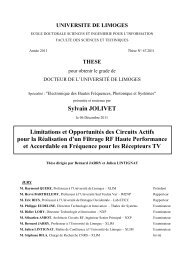Contribution à la conception optimale en terme de linéarité et ...
Contribution à la conception optimale en terme de linéarité et ...
Contribution à la conception optimale en terme de linéarité et ...
You also want an ePaper? Increase the reach of your titles
YUMPU automatically turns print PDFs into web optimized ePapers that Google loves.
CHAPITRE III - METHODOLOGIE DE CONCEPTION OPTMALE EN TERME DE LINEARITE ET DE CONSOMMATION<br />
III.4.2. - UTILISATION DU CRITERE<br />
La courbe <strong>en</strong>veloppe prés<strong>en</strong>tée dans <strong>la</strong> section précéd<strong>en</strong>te m<strong>et</strong> <strong>en</strong> avant le pot<strong>en</strong>tiel <strong>en</strong><br />
<strong>terme</strong> <strong>de</strong> <strong>linéarité</strong> <strong>et</strong> consommation d’une cellule <strong>de</strong>stinée <strong>à</strong> <strong>la</strong> <strong>conception</strong> d’un amplificateur.<br />
Lorsque <strong>la</strong> cellule élém<strong>en</strong>taire est un transistor <strong>de</strong> nombreux paramètres sont susceptibles <strong>de</strong><br />
modifier son comportem<strong>en</strong>t. Les caractéristiques associées <strong>à</strong> chacun <strong>de</strong>s paramètres offr<strong>en</strong>t un<br />
critère ess<strong>en</strong>tiel pour le choix <strong>de</strong>s conditions <strong>de</strong> fonctionnem<strong>en</strong>t. Appliqué <strong>à</strong> différ<strong>en</strong>tes<br />
technologies ou filières il perm<strong>et</strong> <strong>de</strong> sélectionner le transistor optimal.<br />
Nous pouvons faire interv<strong>en</strong>ir ce critère <strong>à</strong> tous les niveaux <strong>de</strong> <strong>la</strong> <strong>conception</strong> :<br />
Choix <strong>de</strong> <strong>la</strong> technologie, filière <strong>et</strong>c,<br />
Détermination <strong>de</strong>s conditions <strong>de</strong> fonctionnem<strong>en</strong>t,<br />
Dim<strong>en</strong>sionnem<strong>en</strong>t d’un amplificateur (choix du nombre <strong>de</strong> cellules<br />
optimisés,<br />
Validation <strong>de</strong> <strong>la</strong> <strong>conception</strong>.<br />
III.4.2.1. - Choix d’une cellule élém<strong>en</strong>taire<br />
Sur Figure III. nous avons tracé les courbes <strong>en</strong>veloppes représ<strong>en</strong>tatives <strong>de</strong> <strong>de</strong>ux<br />
cellules différ<strong>en</strong>tes. Ces <strong>de</strong>rnières peuv<strong>en</strong>t être représ<strong>en</strong>tatives d’une c<strong>la</strong>sse <strong>de</strong><br />
fonctionnem<strong>en</strong>t, d’une technologie, d’une topologie ou <strong>de</strong> tous autres paramètres.<br />
Pour un rapport signal <strong>à</strong> bruit donné, S / B , <strong>la</strong> cellule 2 a un rapport / N proche <strong>de</strong><br />
16 dB <strong>et</strong> <strong>la</strong> cellule 1 proche <strong>de</strong> 17 dB. Comme ce rapport est directem<strong>en</strong>t proportionnel <strong>à</strong> <strong>la</strong><br />
puissance consommée par l’amplificateur, celui conçu avec <strong>la</strong> cellule 2 pourra assurer le<br />
rapport signal <strong>à</strong> bruit du cahier <strong>de</strong>s charges avec une puissance d’alim<strong>en</strong>tation 20 % inférieure<br />
<strong>à</strong> celui conçu avec <strong>la</strong> cellule 1.<br />
C<strong>et</strong> abaque offre un critère visuel <strong>de</strong> comparaison d’amplificateur <strong>en</strong> <strong>linéarité</strong> <strong>et</strong><br />
consommation. Il perm<strong>et</strong> <strong>de</strong> choisir <strong>de</strong> manière objective aussi bi<strong>en</strong> <strong>la</strong> technologie que le<br />
point <strong>de</strong> fonctionnem<strong>en</strong>t d’un amplificateur.<br />
111<br />
P dc
















